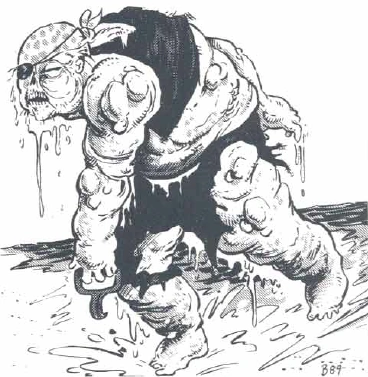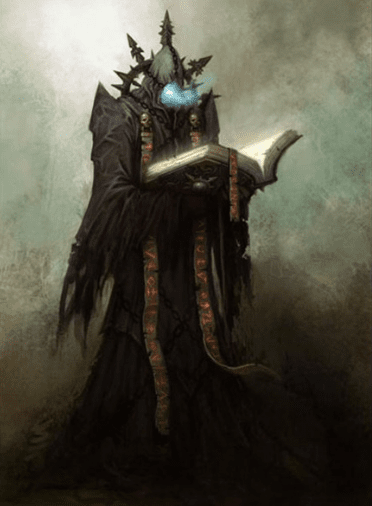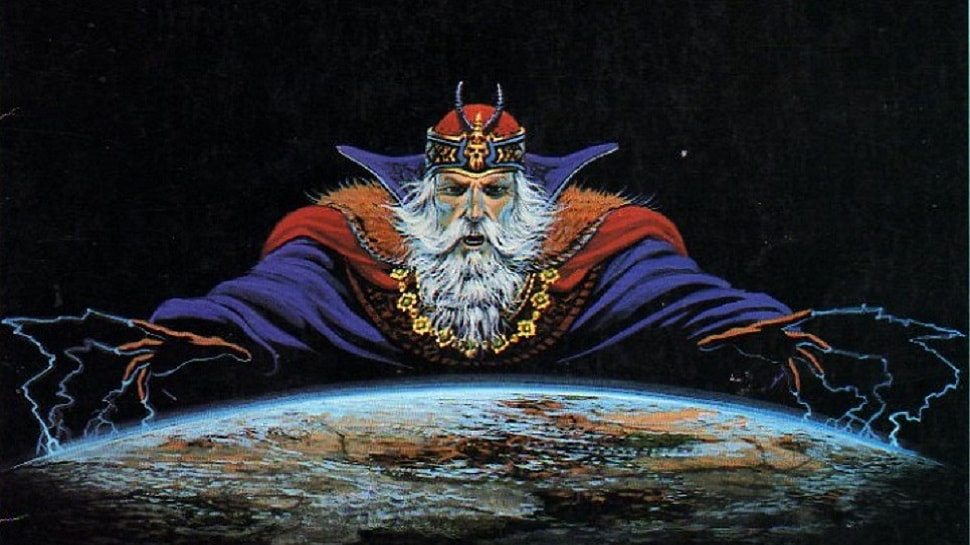It took one bad hit for your character to go down at the wrong time. Your cleric is just out of range, and the closest person to you doesn’t have a healing potion. The most that can be done for you right now is to draw the enemy away from your body while death stares you in the face. You’re on the doorstep, and the door is open.
All that stands between you and getting pulled into the abyss is the roll of a die. You need to make a Death Saving Throw. Picking up your d20, you drop it, watching it fall from your hand and clatter against the tray, tumbling before it comes to a stop. Your heart freezes at the sight of a natural one – that’s two failures immediately.
You look up at the rest of your table, and you can see the fear and pity that mingles in their gaze. The round continues, but it’s a blur. You’re still unconscious with a roll that determines your fate still. It’s back to your turn. Your hand shakes as you pick up your d20: one more try, one more roll. You shut your eyes and roll, not wanting to look – but you need to.
Slowly you peek over at the d20, and your heart soars. The dice gods played with your heart today, but ultimately they gave you success. You jump from your seat, arms flying into the air as you yell, “NATURAL 20!” Your character is stabilized at one hit point, you’re conscious again, and you live another day.
Death Saving Throws 5e Guide: Bottom Line
Death saving throws are usually one of the most terrifying and stressful moments in a player’s career. Your character is on the brink of death, and all that stands between you and the Raven Queen’s presence is the roll of a d20. Except it’s not really.
There are different things and situations that can occur that can entirely skip over the process of rolling death saving throws, throwing you straight into the land of the dead, or yanking you back to the realm of the living.
Healing spells, spare the dying, potions, and some racial features can completely override death rolls to keep you alive. On the other hand, attacks, after you’ve been knocked unconscious or constant damage can skip over any Death Saving Throws to kill you quickly and painfully.
Having a character die can be an excellent way to sunset them so you can bring in someone new, but it can also be very painful – especially if you didn’t want it or didn’t expect it.
What Is It

Death saving throws are a mechanic that is utilized once your character hits zero hit points. You must roll a d20 in order to determine the fate of you and your character. Your character remains unconscious while you make each roll, once every round or every six seconds.
Three failures will result in your character dying, whereas three successes result in your character becoming stabilized while remaining at zero hit points. Rolling 2 to 10 results in one failure. An 11 to 19 results in one success.
Rolling a natural one is immediately two failures, whereas rolling a natural 20 results in your character immediately stabilizing and waking up with a single hit point.
Conditions it Happens Under
The most common condition that death-saving throws take place is during combat. As a player, you are most likely to hit zero hit points when you’re in the middle of combat. There are a lot of things that can go wrong – you can get in over your head in a fight, your healer can be distracted, or there could be a whole slew of other problems that take place.
Regardless, you’re eventually down on the ground, rolling a d20 and praying the dice gods are kind to you today. If you take extra damage while unconscious and making death saving throws, it’s immediately two failed saves. However, this is not the only situation that may cause you to begin making death saving throws.
Not Just In Combat

The second situation in which you may need to start making death saves is outside of combat. This mainly involves you separating yourself from your party. If you find yourself far enough away from your party after taking a massive amount of damage, you may need to start rolling the dice to see if you live or if you die.
Take, for example, this scenario: You and your group are standing on a cliff overlooking the sea. Something falls over the edge – whether it’s important or not, you decide to cliff dive in order to get it and bring it back up to your party. Everyone seems all right with this until you actually jump.
Instead of diving gracefully into the sea, you hit the ground below and take an absolutely massive amount of fall damage. It knocks you unconscious instantly, and you’re left making death saving throws every six seconds until someone can reach you, you stabilize yourself with a natural 20 or three successes, or you die.
I would argue that something like that is more terrifying than getting downed in battle. At least in battle, your party members are usually close. If everyone is prepared, you should all have at least one healing potion on you, or your healer should still have some heal slots left to help.
If you’re extra lucky, someone has the spare the dying cantrip, so at the very least, you can be stabilized. But in this situation, you’re separated from everyone. It’s a race against the clock to get to you before you can expire, or the sea can drag you into its murky depths.
Do You do Death Saving Throws if You’re Drowning?

Speaking of the sea, there comes the question of if you need to make death saving throws if you’re suffocating or drowning. Theoretically, you shouldn’t last long enough for it to matter. You can’t stabilize while you can’t breathe, so unless you roll a natural twenty and suddenly come to your senses, you’ve got a very short period of time before you’re just dead.
We can’t really abide by “real-life rules” when it comes to drowning or suffocating in Dungeons and Dragons, so this is what I would do: Base it off of your Constitution Modifier – the high Con you have, the more time you have to make your death saving throws. (Sorry, squishies, I know this is like a death sentence for you.
On the bright side, you’ll have at least a minute.) You can’t stabilize or regain hit points while you’re actively suffocating, so work it out with your DM. My best suggestion would be to come to consciousness for brief moments (a single round) to at least give you a chance to get out of that situation. If you can’t get out within that round, you fall unconscious again and are back to rolling death saves.
What Overrides a Death-Saving Throw
There are certain things that either override or help you in making your death saving throws, however. These can keep your character alive for even longer, stabilize, or generally take the stress of each roll away.
Spells

Certain spells will nullify the need to make death saving throws. Healing spells will stabilize you and then send you back into the world of consciousness. Others, like Spare the Dying, will stabilize you, but you will remain at zero hit points until you are either fed a healing potion, or someone uses a healing spell on you. Regardless, it will take the stress of being near death off unless someone hits you again.
Racial Traits
If you’re lucky, the race you picked might have a racial trait that keeps you from dying or needing to make death saving throws for just a moment longer. Races like the Hollow One have an ability called Cling to Life, which gives you a 25% chance to regain a single hit point while you’re making a death saving throw.
You need to roll a 16 or higher in order to regain your single hit point, which is better than praying for a natural twenty. Others, like the Ixalan Orc, have an ability called Relentless Endurance, allowing them to continue fighting. When they should have dropped to zero hit points they instead drop to one, which may be all you need to stay alive or win the fight.
Or, if you’re a Barbarian taking the Path of the Zealot, the ability “Rage Beyond Death” will not allow you to go below zero hit points while you’re raging. This means that you cannot fall unconscious so long as you continue to rage.
How You Roll

Roll a natural 20 and you won’t have to make any more death saving throws. If that is too far out of the realm of possibility, however, there are ways to augment your death saves, but you’ll need to have them active before you go unconscious. If you have inspiration, you can give yourself advantage once for your death saving throw.
If you have the Lucky feat or if you’re a Halfing with the trait Lucky, you can reroll any natural one. If you’re a fighter and have Indomitable, you can reroll one failed saving throw. So while these won’t prevent you from dying or from making saving throws, they will certainly help you to stay alive just a little bit longer.
What Happens After You Fail
If you get three failures you die. Your character will pass on into the afterlife and there’s not much that you can do about that. However, there is something that your party members can do about it. While healing spells cannot bring you back to life immediately, there are other spells and ways to go about bringing a dead party member (or NPC) to life.
There’s Still Some Time. Don’t Panic… Yet.
In total there are six spells that can resurrect your characters: Raise Dead, Reincarnate, Resurrection, Revivify, True Resurrection, and Wish. If you have the ability of Divine Intervention, there is also a chance that you can bring a dead character back to life, though it may require a pretty high persuasion check to convince your deity. For the most part, you’ll be pretty dependent on healers to get the job done and keep everyone alive or to bring them back to life.
For The Dungeon Masters

Yes, Dungeon Masters, this small section is for you. This is the section about giving a bit of closure to players who have just lost a character, who know it’s the end. The death of their character or another player’s character can be difficult to deal with, even if it is only fictional.
So give your players a chance to mourn and give a bit of closure. Before a character dies, give the player a chance to let them have some last words, even if they’re in the midst of battle. As DMs we don’t often do saving throws for our characters, not unless they’re important NPCs (whether it’s to the story or to the party).
It is difficult for us to get attached to characters we create knowing they could easily die. Players, on the other hand, don’t usually expect their characters to die. So, unless you’ve worked it out with the player in question, give them a bit of time during the session to mourn and to come to peace with it.
More so, if needed, think of ways that the player’s character doesn’t actually die. If it turns out your player is having a really difficult time with it, there are ways that their character might be able to come back. Is there an artifact or magical object nearby that would have temporarily housed their soul before it could make a return? Perhaps your chosen deity of death took pity and brought them back.
Better yet, what if the Matron of Fate decided that they had not completed their destiny and needed more time? Death doesn’t have to be permanent and it’s important to keep that in mind. If it’s something everyone is okay with, that’s great, but if not, there are workarounds while still keeping Death Saving throws as a mechanic.
If you have worked it out with a player and they want their character to die a heroic death in battle as a way to sunset their character, skip over death saving throws. Tell them to fudge their rolls or better yet, just have the enemy intervene and finish them before they can get too many rolls in. But, it should be clear to the other players that this is a mutual and friendly decision and not just targetted malice.
FAQ
Question: Does Constitution Affect Your Death Saving Throws?
Answer: Unless you’re suffocating, as discussed earlier in the article, no, it doesn’t. Constitution under the circumstances of suffocation, however, may give you slightly longer to survive and get out of that situation.
Question: Can I make any other saving throws while unconscious?
Answer: No, you will immediately fail any saving throws that you need to make. If someone cast a fireball and you needed to make a Dexterity saving throw you would immediately fail the saving throw and immediately have two failed saves. So, if one of your wizard party members literally is not paying attention, you may need to get (friendly) revenge later on.
Question: What is the modifier for a death saving throw?
Answer: You don’t have any modifier. It is a straight roll – you either make it or you don’t. This means that everyone should theoretically be on the same grounding for death saving throws, but in the end, we all know the lucky rollers will be better off.
Question: Do death saves reset?
Answer: Technically, yes. As soon as you stabilize your death saving throws would reset.
In the End
In the end, death-saving throws are the most stressful mechanic in the entirety of Dungeons and Dragons, but there are ways to avoid it or at the very least, give yourself the upper hand. The stressfulness of death saving throws also helps to stress the importance of healers and clerics especially.
A cleric can be the one being who stands in the way of you and the land of the dead, which really does put the power of clerics into an entirely different light. However, if you are the cleric and you’re the one making death saving throws, I am sorry, and maybe your deity will like you enough to give you a bit of help.
- Hand Crossbow 5e Guide – For Everyone but Druids and Wizards - December 16, 2022
- Compelled Duel 5e Guide - November 14, 2022
- Heavily Obscured 5e Guide – The Ins And Outs Of The Dark - October 31, 2022

